Where have cladding fire tests failed?
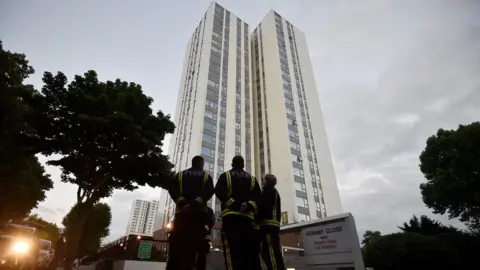 Reuters
ReutersCladding on 259 high-rise buildings has failed fire safety tests, latest figures reveal.
The government announced plans to carry out tests on 600 buildings across the country after the Grenfell Tower fire in North Kensington, west London, on 14 June.
External cladding has been identified as a potential factor in the rapid spread of the fire, which is thought to have left at least 80 people dead.
Details are continuing to emerge about how many high-rise buildings are affected and their locations.
One sample has passed the test but it is not known which building this relates to.

Barnet, north London
Cladding that was put up on three towers in Granville Road in 2012 is to be removed after failing the tests.
Councillor Richard Cornelius, leader of Barnet Council, said the panels were similar to those used on Grenfell Tower but the insulation material used was non-combustible.
"In addition, fire stops have been installed at each floor level and around each window," he said.
"While the difference in the cladding system at Granville Road mitigates the fire risk, we are not prepared to take any chances with the safety of residents."
Brent, north-west London
Cladding on seven buildings in Brent had failed fire safety tests
They include the housing association tower block, Elizabeth House. Elizabeth House does have extra safety features, such as sprinklers, so Brent Council has said there is no immediate risk to residents. London Fire Brigade has also advised it is not a risk.
A decision is due to be made soon on whether to remove all the cladding.
Cambridge, Cambridgeshire
Two buildings in Cambridge have failed cladding sample tests but details of which buildings these are have not been released.
Cambridge City Council has said it runs one building taller than six storeys which has cladding but this block "meets all current building regulations".
Camden, north London
Residents have been evacuated from four blocks on the Chalcots Estate in Swiss Cottage, with five buildings failing cladding safety tests.
Camden Council said it was forced to evacuate the blocks because not only did the external cladding fail tests but there were multiple other fire safety failures as well.
Communities and Local Government Secretary Sajid Javid said more than 1,000 fire doors were missing from five blocks in the borough and a number of stairways were not accessible.
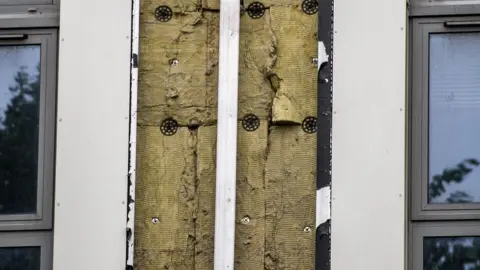 EPA
EPADoncaster
Decorative window capping is to be removed from a high-rise block in Doncaster.
Doncaster Council said the capping on the external stairwell windows of Silverwood House was being removed as a precaution, adding in a letter to the residents: "We do not believe there is any danger."
The capping was found to have "some fire retardant properties", the letter added.
It follows a review of the fire risk of the council's nine blocks of flats.
Ealing, west London
One unidentified tower block has failed a fire safety test.
The council said none of its buildings is clad in the same or similar materials to those used at Grenfell Tower.
Hammersmith and Fulham, west London
The council is having further tests carried out on the panels on Shepherd's Court, where a fire broke out last year.
A report into the blaze last August highlighted the external cladding as a probable cause of the fire spreading up six floors. No-one was injured.
Four buildings in the area have failed fire safety tests.
Haringey, north London
Cladding will be removed from a 22-storey tower block, River Apartments, in Cannon Road.
Newlon Housing Trust says the building's panels "are of the type over which concerns have been raised" and will be replaced with a "suitable, rigorously tested alternative".
Hounslow, west London
Outer cladding - made of two thin aluminium sheets with polyethylene filler in between - them is being removed from Clements Court tower in Cranford, said to have cladding .
Hounslow Council leader Steve Curran said the insulation material was non-combustible - unlike that used on Grenfell Tower but that the council was now looking into how "best and swiftly" it could be removed.
Islington, north London
The council is to remove cladding from Braithwaite House after it was found to have cladding made of aluminium composite material (ACM).
It is also stepping up safety measures which include fire safety patrols taking place day and night until the panels are removed.
The council has also sent samples of cladding from blocks on the Harvist Estate and Brunswick Estate for testing but has not yet had the results.
Lambeth, south London
The council sent samples from all 31 of its blocks that are fully or partially clad and more than six storeys high.
Samples of cladding used on three buildings in the area have failed the fire safety test.
Lambeth Council has only commented on one so far which it said was "built, owned and managed by Network Homes, a housing association, rather than Lambeth Council".
Lewisham
The council has ordered the removal of cladding from three buildings in New Cross following advice from the London Fire Brigade.
The buildings affected are Gerrard House and two at Hatfield Close.
Andrew Potter, chief executive at Lewisham Homes, said: "We are working closely with the London Fire Brigade to ensure residents are safe in their homes and will put 24-hour fire safety patrols into each of the buildings."
Liverpool
The council says it is removing cladding from Marwood Towers, in Everton, as a "precautionary measure" after it failed a safety test.
It says fire marshals will be deployed while the work takes place on the building, which has been retro-fitted with sprinklers.
Manchester
A spokesman for One Manchester housing group said it was taking "immediate action" to remove all cladding made from aluminium composite materials.
In total, 16 of the housing group's high-rise tower blocks have failed safety tests. The company previously said it would remove cladding from five of their buildings but added its insulation was not flammable.
It said there are no plans to evacuate for the blocks - Westcott Court, Duffield Court and Fulton Court in Hulme and Platt Court and Worsley Court in Rusholme, Manchester.
Elsewhere in Manchester, 78 panels are being removed from one area of the Village 135 development in Wythenshawe.
The new building has decorative cladding on its top levels in one part, and tests have shown it could be made of similar materials to those at Grenfell Tower.
Four additional buildings have failed cladding tests in Manchester, bringing the city's total to 20.
Newcastle upon Tyne
Student accommodation, St James' Point is one of two buildings in the city to have failed fire safety tests.
The building has Reynobond PE cladding, which is the same as that used on Grenfell Tower.
The council said it was working with both the fire service and the building's owners following the test results.
Newham, east London
Three tower blocks in the borough were found to have panels that caused concern, the Department for Communities and Local Government said.
They have been named as Ferrier Point, Nicholls Point and Tanner Point.
Norwich
Brennan Bank, a development near Norwich City Football Club, was the first to be tested and residents have been told remedial work is planned soon.
Broadland Housing also said cladding at Brennan Bank contained an aluminium composite material.
Oxford
Oxford City Council has said two tower blocks will have their cladding removed, to be replaced with "non-combustible material".
The rain-screen cladding on Evenlode and Windrush Towers, in Blackbird Leys, has been identified as "a risk" after testing.
Neither building will have to be evacuated.
Plymouth
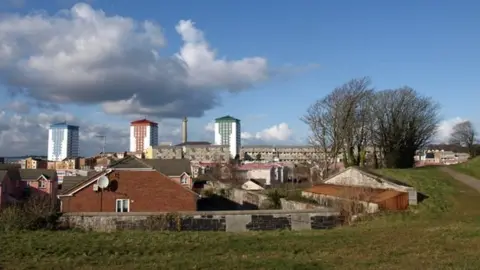 Derek Harper
Derek Harper Three blocks on the Mount Wise Tower estate were found to have cladding made from similar material to Grenfell Tower, which is due to be removed by the end of November 2017.
John Clark, chief executive of Plymouth Community Homes, said it was committed to removing and replacing the cladding as soon as possible but it was a "large and complex programme of works".
He added that extra safety measures were being introduced, such as a sprinkler system, which would be installed in the next few months.
Portsmouth
The city council is removing cladding from Horatia House and Leamington House in Somerstown "as a precautionary measure".
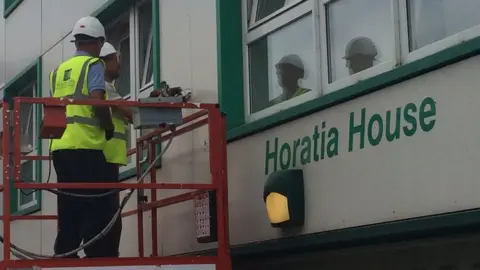
Salford
Twenty-nine blocks of flats have so far failed safety tests in Salford - more than any other area, according to the latest figures.
Cladding started to be removed from nine tower blocks, containing more than 850 flats, on 25 June.
Mayor Paul Dennett said: "We decided not to wait around and now the test results have come back it has just confirmed that this was definitely the right call to make."
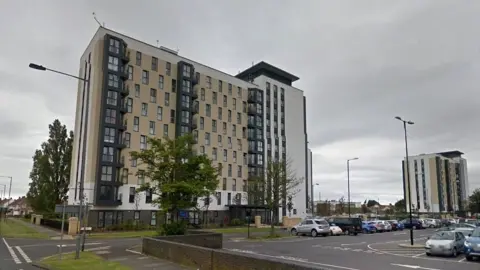 Google
GoogleSefton
Two high-rise buildings in Merseyside have failed fire tests and cladding is being "removed immediately", a housing firm has said.
The cladding, on Cygnet and Wren House on St James Drive, Bootle, will be removed to ensure the safety of tenants "as a precautionary measure", landlords One Vision Housing said.
The government says two buildings in Sefton had also been identified as being at risk.
Sheffield
Sheffield City Council said cladding installed in a refurbishment of the 16-storey Hanover House, in Broomhall, had failed tests and would be taken down.
The council said the cladding was not the same type used at Grenfell Tower.
The council has already pledged to install sprinkler systems in its 24 tower blocks.
Slough
One unidentified tower block in the borough has failed a fire safety test.
The council said none of the council-owned buildings had the same cladding as that used at Grenfell Tower.
Southampton
One unidentified building has failed a fire safety test.
The council said no combustible cladding materials or cladding similar to that used on Grenfell Tower were on its tower blocks.
A number of the council's high-rise tower blocks will be fitted with sprinklers.
Southwark, south London
Two unidentified buildings have failed a fire safety test.
A council statement said: "We do not have the same cladding system anywhere on our council tower blocks but we do have some aluminium or similar facing that we are investigating on some of our lower blocks and we are arranging urgent checks to see whether any further action should be taken."
Stockton-on-Tees
Work to remove cladding from three buildings at Kennedy Gardens in Billingham will begin "as soon as physically possible", a social housing company has said.
"We had specified that the cladding should be fire-retardant, and following tests that have shown that this is not the case," Thirteen Group chief executive Ian Wardle said.
The company said it was safe enough for residents to remain in their homes.
Sunderland
Housing association, Gentoo, said the material had been removed as a precautionary measure, even though none of its buildings had the same cladding as Grenfell Tower.
Sutton, south London
The council said one tower block - Chaucer House - has failed a fire safety test.
A joint letter from Sutton Council, Sutton Housing Partnership and London Fire Brigade to residents, said they "are satisfied that your homes are still safe".
Tower Hamlets, east London
Tower Hamlets Council said cladding on Denning Point tower block "did not fully comply with the requirements" of the safety tests.
The building has the fire-retardant version of the ACM panels, according to a joint statement from the council and owners EastendHomes.
A 24/7 fire patrol has been introduced to inspect communal areas through the night.
Another, unidentified, tower block, is also affected.
Trafford, Greater Manchester
Trafford Housing Trust said five tower blocks have failed fire safety tests and it is working with Greater Manchester Fire service to decide what action to take.
The buildings are Pickford Court, Clifton Court and Grafton Court, all in Old Trafford, and Empress Court and Princess Court, both in Stretford.
There are 24-hour wardens in place in the blocks and Trafford Housing Trust has changed its fire drill advice from "stay put" to a managed evacuation.
Waltham Forest, north east London
One unidentified building in the borough has failed a fire safety test.
The council says no blocks in the area use the same cladding as was installed at Grenfell Tower.
Wandsworth, south London
Two buildings with cladding have failed fire safety tests in Wandsworth, with cladding to be removed from Castlemaine Tower in Battersea.
London Fire Brigade has said it is safe for residents to remain in the building while the work is carried out but fire marshals will be on duty in the block 24 hours a day as an additional safety measure.
The second high-rise, Sudbury House, has been deemed safe for people to remain in their homes, .
The cladding is due to be removed "as quickly as possible" according to the council.
Unidentified buildings
A further 69 buildings in 18 areas have also failed the tests, but have not been indentified by the Department for Communities and Local Government.
